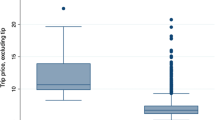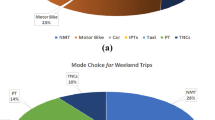Abstract
Ride-hailing services (e.g., Uber, Lyft) have drawn attention as a disruptive innovation in the tourism industry as they provide a new option for transport while on vacation or a business trip. Few studies have examined how travellers perceive the value of this new mode of transportation and modelled their intent to use ride-hailing services. Millennial consumers are known for their early adoption of smart technologies with different supply chains and portable internet devices (e.g., cell phones). This research examines the impact of perceived value on millennial travellers’ intentions to use ride-hailing services in two rapidly changing tourism economies embracing smart phone access to transport services. Primary data were collected with millennials located in urban universities in the US and China. Data were analysed using ordinary least squares estimates. The results revealed that price and relational value positively influenced millennial travellers’ intentions to use ride-hailing services in both samples. These influences remained significant after controlling for previous experiences with mobile technology, perceived safety, and regulations for ride-hailing services. The two millennial samples, however, exhibited different consumer factor influences. While quality and perceived regulations for ride-hailing services predicted millennial travellers’ use intentions in the US sample, previous experience of using mobile technology influenced travellers’ use intentions in the Chinese sample. As companies like Uber and Lyft expand and new providers enter the market, consumer behaviour research on perceived value can inform how business models might differ across countries and services should be tailored for each destination.

Similar content being viewed by others
Notes
We tested the inclusion of “levels of previous experience with ride-hailing” as a ratio control variable. The results indicate this variable to be insignificant for both U.S. and Chinese samples that were self-reported ride-hailing users.
References
Alemi F, Circella G, Handy S, Mokhtarian P (2017) What influences travelers to use Uber? Exploring the factors affecting the adoption of on-demand ride services. TRB 96th Annual meeting Compendium of Papers, No: 17-05630
Amaro S, Andreu L, Huang S (2018) Millennial’s intentions to book on Airbnb. Curr Issues Tour 22(18):2284–2298
Amirkiaee SY, Evangelopoulos N (2018) Why do people rideshare? An experimental study. Transp Res Part F 55:9–24
Benbasat I, Barki H (2007) Quo vadis, TAM? J Assoc Inf Syst 8(4):211–218
Bernardi M (2018) Millennials, sharing economy and tourism: the case of Seoul. J Tour Futures 4(1):43–56
Blut M, Wang C, Schoefer K (2016) Factors influencing the acceptance of self-service technologies: A meta-analysis. J Serv Res 19(4):396–416
Bomey N (2016) Millennials spurn driver’s license, study finds. USA Today. https://www.usatoday.com. Accessed 10 Apr 2020
Brislin RW (1970) Back-translation for cross-cultural research. J Cross Cult Psychol 1(3):185–216
Brown TA (2015) Confirmatory factor analysis for applied research. Guilford Express, New York
Caselli F, Coleman WJ (2001) Cross-country technology diffusion: the case of computers. Am Econ Rev 91(2):328–335
Choi M, Law R, Heo CY (2018) An investigation of the perceived value of shopping tourism. J Transp Res 57(7):962–980
Curran PJ, West SG, Finch JF (1996) The robustness of test statistics to nonnormality and specification error in confirmatory factor analysis. Psychol Methods 1(1):16–29
Dasgupta S, Agarwal D, Ioannidis A, Gopalakrishnan S (1999) Determinants of information technology adoption: an extension of existing models to firms in a developing country. J Glob Inf Manag 7(3):30–40
Dewan S, Kraemer KL (2000) Information technology and productivity: evidence from country-level data. Manag Sci 46(4):548–562
Fornell C, Larcker DF (1981) Evaluating structural equation models with unobservable variables and measurement error. J Mark Res 18(1):39–50
Geron T (2013) California becomes first state to regulate ridesharing services Lyft, Sidecar, UberX. Forbes. https://www.forbes.com. Accessed 10 Apr 2020
Gill D, Byslma B, Ouschan R (2007) Customer perceived value in a cellar door visit: the impact on behavioural intentions. Int J Wine Bus Res 19(4):257–275
Godelink R (2017) Millennials and the sharing economy: lessons from a buy nothing new, share everything month’s project. Environ Innov Soc Transit 23:40–52
Gupta M, Esmaeilzadeh P, Uz I, Tennant VM (2019) The effects of national cultural values on individuals’ intention to participate in peer-to-peer sharing economy. J Bus Res 97:20–29
Gurău C (2012) A life-stage analysis of consumer loyalty profile: comparing generation x and millennial consumers. J Consum Mark 29(2):103–113
Gustke C (2016) China’s $500 billion mobile shopping mania. CNBC. https://www.cnbc.com. Accessed 10 Apr 2020
Guttentag D, Smith S, Potwarka L, Havitz M (2017) Why tourists choose Airbnb: a motivation-based segmentation study. J Travel Res. https://doi.org/10.1177/0047287517696980
Gwinner KP, Gremler DD, Bitner MJ (1998) Relational benefits in services industries: the customer’s perspective. J Acad Mark Sci 26(2):101–114
Hackbarth G, Grover V, Mun YY (2003) Computer playfulness and anxiety: positive and negative mediators of the system experience effect on perceived ease of use. Inf Manag 40(3):221–232
Hair JF, Black WC, Babin BJ, Anderson RE (2010) Multivariate data analysis, 7th edn. Pearson, Upper Saddle River
Hamari J, Sjöklint M, Ukkonen A (2016) The sharing economy: why people participate in collaborative consumption. J Assoc Inf Sci Technol 67(9):2047–2059
Hartl B, Hofmann E, Kirchler E (2016) Do we need rules for “what’s mine is yours”? Governance in collaborative consumption communities. J Bus Res 69(8):2756–2763
Hu L, Bentler PM (1999) Cutoff criteria for fit indices in covariance structure analysis: conventional criteria versus new alternatives. Struct Equ Model 6(1):1–55
Jiang JJ (2019) More Americans are using ride-hailing apps. Pew Research Center. https://www.pewresearch.org/fact-tank/2019/01/04/more-americans-are-using-ride-hailing-apps/
Jin N, Lee S, Lee H (2015) The effect of experience quality on perceived value, satisfaction, image and behavioral intention of water park patrons: new versus repeat visitors. Int J Tour Res 17(1):82–95
Jones C (2016) More business travellers are ditching rental cars and turning into Uber and Lyft. USA Today. https://www.usatoday.com. Accessed 10 Apr 2020
Kellogg DL, Youngdahl WE, Bowen DE (1997) On the relationship between customer participation and satisfaction: two frameworks. Int J Serv Ind Manag 8(3):206–219
Kim TG, Lee JH, Law R (2008) An empirical examination of the acceptance behaviour of hotel front office systems: an extended technology acceptance model. Tour Manag 29(3):500–513
Lanset M (2018) Here's how much millennials spend on Uber and Lyft in major US cities every month. Business Insider. https://www.businessinsider.com. Accessed 10 Apr 2020
Lavieri PS, Bhat CR (2019) Investigating objective and subjective factors influencing the adoption, frequency, and characteristics of rid-hailing trips. Transp Res Part C 105:100–125
Lee S, Lee WJ, Yoo KH (2020) Millennial ride-share passengers’ pro-sustainable behaviours: norm activation perspective. Asia Pac J Tour Res 25(1):15–26
Li F (2016) Chinese use of ride hailing apps rising. China Daily. http://www.chinadaily.com.cn/business/motoring/2016-06/06/content_25621768.htm. Accessed 10 Apr 2020
Lobel O (2016) The law of the platform. Minnesota Law Rev 101(1):87–166
Lu J, Yu C, Liu C, Wei J (2017) Comparison of mobile shopping continuance intention between China and USA from an espoused cultural perspective. Comput Hum Behav 75:130–146
MacCallum RC, Browne MW, Sugawara HM (1996) Power analysis and determination of sample size for covariance structure modelling. Psychol Methods 1(2):130–149
Malhotra NK, Kim SS, Patil A (2006) Common method variance in IS research: a comparison of alternative approaches and a reanalysis of past research. Manag Sci 52(12):1865–1883
Malik G, Rao AS (2019) Extended expectation-confirmation model to predict continued usage of ODR/ride hailing apps: role of perceived value and self-efficacy. Inf Technol Tour 21:461–482
Marshall A (2019) A third of Americans use ride-hail, Uber and Lyft need more. Wired. https://www.wired.com/story/uber-lyft-ride-hail-stats-pew-research/
Mayzlin D, Dover Y, Chevalier J (2014) Promotional reviews: an empirical investigation of online review manipulation. Am Econ Rev 104(8):2421–2455
Meuter ML, Bitner MJ, Ostrom AL, Brown SW (2005) Choosing among alternative service delivery modes: an investigation of customer trial of self-service technologies. J Mark 69(2):61–83
Min S, So KKF, Jeong M (2019) Consumer adoption of the Uber mobile application: insights from diffusion of innovation theory and technology acceptance model. J Travel Tour Mark 36(7):770–783
Möhlmann M (2015) Collaborative consumption: determinants of satisfaction and the likelihood using a sharing economy option again. J Consum Behav 14:193–207
Mousavi R, Hazarika B, Chen K, Rienzo T (2020) The role of dissonance reduction and co-creation strategies in shaping smart services satisfaction—the case of Uber. Behav Inf Technol. https://doi.org/10.1080/0144929X.2020.1795258
Mozur P (2016) Didi Chuxing and Uber, popular in China, are now legal, too. New York Times. https://www.nytimes.com. Accessed 10 Apr 2020
Muthén, LK, Muthén BO (2015) Mplus User’s Guide, 7th edn. Los Angeles
Nguyen-Phuoc DQ, Su DN, Tran PTK, Le DTT, Johnson LW (2020) Factors influencing customer’s loyalty towards ride-hailing taxi services—a case study of Vietnam. Transp Res Part C 134:96–112
OECD (2016) OECD tourism trends and policies 2016. OECD Publishing, Paris. https://doi.org/10.1787/tour-2016-en
Orcher LT (2014) Conducting research: social and behavioral science methods, 2nd edn. Pyrczak Publishing, Los Angeles
Parasuraman A, Colby CL (2015) An updated and streamlined technology readiness index: tri 2.0. J Serv Res 18(1):59–74
Parasuraman A, Zeithaml VA, Malhotra A (2005) E-S-QUAL: a multiple-item scale for assessing electronic service quality. J Serv Res 7(3):213–233
Phocuswright (2016) Mobile, millennials and emerging markets: the next wave in global travel. http://www.phocuswright.com/Free-Travel-Research/Mobile-Millennials-and-Emerging-Markets-The-Next-Wave-in-Global-Travel. Accessed 10 Apr 2020
Podsakoff PM, MacKenzie SB, Lee JY, Podsakoff NP (2003) Common method biases in behavioral research: a critical review of the literature and recommended remedies. J Appl Psychol 88(5):879–903
Rogers EM (2003) Diffusion of innovations. Free Press, New York
Sánchez J, Callarisa L, Rodríguez RM, Moliner MA (2006) Perceived value of the purchase of a tourism product. Tour Manag 27(3):394–409
Schiopu AF, Pădurean AM, Tală ML, Nica A (2016) The influence of new technologies on tourism consumption behavior of the millennials. Amfiteatru Econ J 18(10):829–846
Smith A (2016) Shared, collaborative and on demand: the new digital economy. https://www.pewresearch.org/internet/2016/05/19/on-demand-ride-hailing-apps/. Accessed 12 Dec 2020
Smith JB, Colgate M (2007) Customer value creation: a practical framework. J Mark Theor Pract 15(1):7–23
Sweeney JC, Soutar GN (2001) Consumer perceived value: the development of a multiple item scale. J Retail 77(1):203–220
Synder T (2020) Back to school statistics. Institute of Education Science. https://nces.ed.gov/fastfacts/display.asp?id=372. Accessed 13 Dec 2020
Tornatzky LG, Fleischer M (1990) The processes of technological innovation. Lexington Books, Lexington
Tussyadiah IP (2016) Factors of satisfaction and intention to use peer-to-peer accommodation. Int J Hosp Manag 55:70–80
Tussyadiah IP, Pesonen J (2018) Drivers and barriers of peer-to-peer accommodation stay—an exploratory study with American and Finnish travellers. Curr Issues Tour 21(6):703–720
University of Michigan Transportation Research Institute (2016) More Americans of all ages spurning driver’s licenses. http://www.umtri.umich.edu. Accessed 10 Apr 2020
UNWTO (2016) Global report on the power of youth travel. UNWTO, Madrid
UNWTO (2017) New platform tourism services (or the so-called sharing economy): understand, rethink and adapt. UNWTO, Madrid
Veiga C, Santos MC, Águas P, Santos JAC (2017) Are millennials transforming global tourism? Challenges for destinations and companies. Worldw Hosp Tour Themes 9(6):603–616
Venkatesh V, Morris MG, Davis GB, Davis FD (2003) User acceptance of information technology: toward a unified view. MIS Q 1:425–478
Wang X, He F, Yang H, Gao HO (2016) Pricing strategies for a taxi-hailing platform. Transp Res Part E 93:212–231
Williams P, Soutar GN (2009) Value, satisfaction and behavioral intentions in an adventure tourism context. Ann Tour Res 36(3):413–438
Yang K, Jolly LD (2009) The effects of consumer perceived value and subjective norm on mobile data service adoption between American and Korean consumers. J Retail Consum Serv 16(6):502–508
Zhu K, Kraemer KL (2005) Post-adoption variations in usage and value of e-business by organizations: cross-country evidence from the retail industry. Inf Syst Res 16(1):61–84
Author information
Authors and Affiliations
Corresponding author
Additional information
Publisher's Note
Springer Nature remains neutral with regard to jurisdictional claims in published maps and institutional affiliations.
Supplementary Information
Below is the link to the electronic supplementary material.
Rights and permissions
About this article
Cite this article
Lee, S., Lee, W., Vogt, C.A. et al. A comparative analysis of factors influencing millennial travellers’ intentions to use ride-hailing. Inf Technol Tourism 23, 133–157 (2021). https://doi.org/10.1007/s40558-021-00194-6
Received:
Revised:
Accepted:
Published:
Issue Date:
DOI: https://doi.org/10.1007/s40558-021-00194-6




